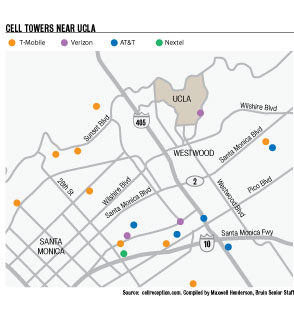It was late on a Thursday night, and as she was walking from the dorms down the poorly lit, forested trail to the apartments, she realized she had no idea where the club meeting was.
She pulled out her cell phone and her heart sank. No service, again.
The initial optimism Lauren Chu left her room with quickly vanished and was immediately replaced with nervousness once she realized she could not call the other club members to find out where they were.
Now lost in the apartments, she could not even call her roommate to meet up with her so she wouldn’t have to walk back to the room alone.
Chu, a second-year psychology student, recalls the night she got lost as a time when having a functioning cell phone would have undoubtedly put her at ease and allowed her to connect with friends when she needed them the most.
Many students at UCLA have experienced similar issues with their cell phone service, particularly if they live on the Hill and have AT&T.
Lack of reception has forced some students to change how they maintain communication with family and friends. They must schedule calls or leave their dorm room to find a spot outside where there is reception.
The persisting issue with service has driven some students to seek out alternative solutions.
Third-year business economics student James Tsuffis and his roommates, after struggling with the inability to get phone service in the dorms, decided they would attempt to find other students who were willing to split the cost of a MicroCell device.
The MicroCell is a product put out by AT&T that authorizes the connection of up to 10 phone numbers, providing those users with voice and data coverage that they wouldn’t otherwise have, said Kathy Fain, an AT&T customer service representative.
The device costs about $150 and provides service up to 5,000 square feet from the base station, Fain said.
While data services on the MicroCell are billed at standard rates, some students simply do not have the money to pay for the device.
For AT&T, problem service areas seem to be near water or a dense area of trees, Fain said. The structure of a building can have an effect on wireless service as well.
Students with other providers, such as T-Mobile, Sprint and Verizon Wireless seem to rarely, if at all, experience problems with their service.
“I have T-Mobile, and it works everywhere, (even) in the dorms and hallways,” said Alex Hernandez, a third-year film and television production student. He added that it is frustrating trying to contact friends who have poor service.
“Sometimes I’ll call them, and it will go straight to their voice mail,” he said.
The quality of reception students experience can be accredited to the technologies used by the different providers.
“The type of technology we use requires us to build single cell sites that provide the same coverage as other companies that use three cell sites,” said Ken Muche, a media relations representative for Verizon Wireless.
According to Muche, the more cell sites present, the more times a phone’s service is transferred among those cell sites, and the more likely it is that the call will drop ““ so having more cell towers is not necessarily an advantage.
The lower the bandwidth that a company buys, the farther their service can penetrate deep into buildings without compromising the call quality, Muche added.
AT&T users should not panic though, as Residence Telephone Services in conjunction with AT&T will be installing new cell phone service towers in the next six months, said Michael Schilling, executive director of Communications Technology Services.
So until the new cell towers are installed, students may have to continue to plan their phone calls to adjust to the lack of service they may experience.
“I would feel safer if I had better service,” Chu said.
